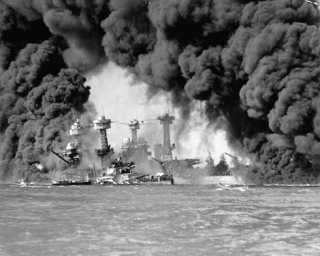Facts About the Attack on Pearl Harbor
-
Although the aerial attack was very successful, the submarines failed to finish off any wounded ship inside the harbour.
- The attack’s success surprised the Japanese as much as the Americans.
- The last part of the decoded Japanese message stated that U.S. relations were to be severed.
- The Japanese attack force was under the command of Admiral Nagumo.
- Japansese force consisted of six carriers with 423 planes.
- At 6 a.m. the first Japanese attack wave of 83 planes took off.
- Nickname for Pearl Harbor is “Gibraltar of the Pacific.”
- Eighteen U.S. ships were hit.
-
President Franklin D. Roosevelt said, “December 7, 1941, a date which will live in infamy,” in reference to the attack.
- Three prime targets escaped damage, the U.S. Pacific Fleet aircraft carriers, the Lexington, Enterprise and Saratoga. They were not in the port when the attack took place.
- Another target, the base fuel tanks also escaped damage.
- Casualties included 2,335 servicemen and 68 civilians.
- 1178 people were wounded.
- The day after the attack the U.S. and Britain declared war on Japan.
- Pearl Harbor is the Naval Base for the U.S. Pacific Fleet.
- Pearl Harbor is the headquarters of the U.S. Pacific Fleet.
- Pearl Harbor has 10 square miles of navigable water.
- The harbour is on the southern coast of Oahu.
-
The harbour is artificially improved.
- The attack was the climax of a decade of worsening relations between the U.S. and militaristic Japan.
- A U.S. embargo on necessary supplies for war prompted the attack on Pearl Harbor.
- The Japanese Admiral Yamamoto Isoroku planned the attack with great care.
- All of the planes on the Japanese ships were fully fueled and armed.
- The Japanese planes took off about 90 minutes from Pearl Harbor.
- The president at the time of the attack was Franklin D. Rooselvelt.
- The attack brought the United States into World War II.
- The Japanese fleet had 30 ships.
- The Japanese were interested in the Hawaiian islands since the islands were annexed by the U.S. in 1898.
- An admiral said, “leaving aside the unspeakable treachery of it, the Japanese did a fine job.”
- Japanese suffered just small losses.
- The attack crippled the United States fleet.
- The Japanese deceived the U.S. by saying false statements and expressed interest in continued peace.
- Americans think of the attack as very dishonorable.
- The attack was planned weeks in advance.
- The main reason for the attack was over economic issues.
- Because of the unpreparedness of the U.S. military, Admiral Husband Kimmel and General Walter Short were relieved of duty.
- The attack severely crippled the U.S. naval and air strength in the Pacific.
- Of the eight battleships, all but the Arizona and Oklahoma were eventually repaired and returned to service.
- On December 8, 1941, Congress declared war on Japan with only one vote against it. The vote against it was of Represenative Jeannette Rankin of Montana, who had also voted against U.S. entry into World War I.
- Once the fleet was out of action, Japan would be able to conquest a great area.
- A U.S. Army private who noticed the large flight of planes on his radar screen was told to ignore them because a flight of B-17s from the continental U.S. was expected at the time.
- More than 180 U.S. aircraft were destroyed.
-
During the attack the USS Arizona sank with a loss of more than 1,100 men.
- A white concrete and steel structure now spans the hull of the sunken ship as a memorial.
- The memorial was dedicated on May 30, 1962.
- U.S. officials had been aware that an attack by Japan was probable, but did not know the time or place it would occur.
- Pearl Harbor was not in the state of high alert when the attack started, Anti-Aircraft guns were left unmanned.
- The Americans were taken completely by surprise.
- The main targets for the first wave was the airfield and battleships.
- The second wave targets were other ships and shipyard facilities.
- The air raid lasted until about 9:45 a.m.
Special thanks to www.bigsiteofamazingfacts.com and www.absoluteastronomy.com












 The Mind of Adam J. Kovitz
The Mind of Adam J. Kovitz